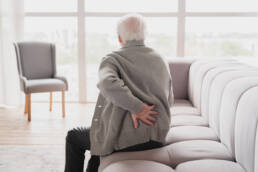How Structural Chiropractors Approach Spinal Misalignment Differently
Structural chiropractors will approach spinal misalignment issues differently than traditional chiropractors or medical doctors. These health professionals, including chiropractors, undergo intense training regarding the spine, back, neck and other musculoskeletal structures.
They also learn precise therapeutic techniques, treatments, procedures and other treatment therapies to not only treat just the presenting symptoms but seeking to diagnose and treat the underlying cause or causes of the spinal misalignment itself.
In general, structural chiropractors will use the following 5 interventions when dealing with spinal misalignment.
What Is Spinal Misalignment?
Spinal misalignments occur more often than you might think. Most of the time, the spine and related structures of the body become misaligned due to some type of forceful impact often during an accidental event or other trauma. In most instances, these bumps and jars are only slight, and the person often does not really remember the initial injury event.
Over time, those small spinal misalignments cause the body to compensate for the weakened and/or injured area. This can exert too much pressure on vulnerable soft structures or vulnerable joints causing yet even more tissue damage and injury. By the time that the person experienced enough pain, joint stiffness or mobility issues that do not go away with standard home remedies and other usual treatments, the misalignment problem is likely to have become serious.
Common Causes of Spinal Misalignment
There are many potential causes of spinal misalignment issues that range from small bumps, a sprained ankle or other sports injury or a more severe injury causing occasion like a motor vehicle accident.
Causes of spinal misalignment include:
- Sports injuries – sprains, bruises or contusions
- Recent illnesses that made the body weakened or more vulnerable
- Motor vehicle accidents
- Strained muscles during active pursuits – muscle strain from hard workout session
- Muscle, tendon, ligament tears or other injury
- Whiplash
- Falls
- Overuse of muscles or straining when lifting heavy objects
- Poor posture – standing or sitting for long time periods
- Wearing shoes without proper support
- Chronic health conditions like osteoporosis, arthritis or others that impact the spine
What Are Some of the Main Goals of Structural Chiropractic Care?
Although each client who decides to undergo structural chiropractic care will have very different treatment and goal needs, there are some main goals that this type of chiropractic care hopes to do.
These main goals of structural chiropractic care and treatments include:
- A better and improved supply of nutrients
- Overall improved strength and function
- Prevention or reduction of nerve pressure that causes discomfort
Better Nutrient Supply
Some of the body’s joints do not have an actual blood supply. Individuals may notice that their joints and body feel stiff and achy if they sit motionless for too long of a time period. These joint structures receive their nutrient supply when the joints are moved and flexed.
This fluid is otherwise termed synovial fluid, and it is the lubricant that greases the joint structures when in motion. When the body has been sedentary, muscle groups can cause discomfort due to the lack of use which gets worse over time.
Structural chiropractic techniques, procedures and adjustments can help to moisten up those critical area proving the necessary lubricant in the process. When performed correctly for the recommended time frame, these treatments can improve joint flexibility and increase range of motion.
Improved Body Strength & Function
When a person has had chronic joint pain for some time, they often despair of ever having a pain-free day again. The brain is resilient, and the brain can indeed be retrained to correct whatever alignments are off by targeting certain joint structures currently causing discomfort and stiffness.
As the client goes through the motions and body positions, they can help the brain react differently to certain body positions hopefully to decrease any residual pain and discomfort as the new information is stored in the tiny neurons for the next stages of healing.
The repetitive motions and body positioning that structural chiropractic care can provide help to reset the body in a sense. Over time, those worked areas will begin to strengthen. That strength then helps to improve the function of that targeted region.
Relief or Reduction of Pain Caused by Nerve & Nerve Bundle Pressure
Nerves and nerve bundles are soft structures of the body. As such, they are prone to inflammation should any increase of pressure be exerted onto them. This could be a herniated disc or a joint that has become stuck into an odd position near these nerves. A structural chiropractor can help to pinpoint the source of the nerve being crushed and relieve or at least reduce the discomfort by relieving that undesired pressure.
The following 5 interventions are often used by structural chiropractors when treating a client with spinal misalignment of some source.
Intervention #1: Rehabilitation Therapy Using Exercise & Stretching
A knowledgeable structural chiropractor will often use rehabilitation-type therapies that often include exercise routines and stretches. These movements will be carefully performed with lots of support, especially in the early stages of treatment.
Each client will be thoroughly examined and asked to complete an in-depth personal and family history report. These measures help the chiropractor to get a good idea of what the body is going through in order to make an accurate diagnosis and develop an effective and personalized treatment care plan.
Intervention #2: Healthy Nutritional Teaching & Guidance
The human body is designed to get the energy it needs from the diet that the person ingests on a regular basis. If someone eats poorly, this will have a negative impact on the body and all its smaller systems. If the nutrition deficiency is minor and/or is corrected within a short time period, the person may not even notice ill effects.
However, continued poor nutritional status will eventually become noticeable over time. The body will still pull in the energy stores it needs for survival at the expense of many of the less important body systems. An example of this is the body pulling calcium out of the person’s bones which will cause those bones to become weakened and brittle as time goes by. This then puts the person at great risk for broken bones and injuries should they suffer a fall or other accident.
As a result, structural chiropractors will incorporate nutritional guidance and education into their overall care plans for each unique client. If the client is severely deficient in these necessary nutrients, they may also call-in other reinforcements, like setting up the client with a seasoned nutritionist or enrolling the client in community nutrition classes, to give the client time and the resources to change their eating habits for the better.
The human body does have built-in healing mechanisms, but these work best when the client is eating a nutritious, well-rounded and healthy diet on a regular basis. Extra nutritional assistance for obese clients may also be helpful too.
Oftentimes, a client will be given diet recommendations and personalized exercise goals to be completed at home. Along with diet, exercise, and nutritional counseling, the client may also be helped with negative lifestyle choices like quitting smoking, avoiding too much alcohol, and other lifestyle issue changes through client-specific counseling and supportive therapies in the community, as an individual or through family counseling and other support network options.
Chiropractors today are part of the greater healthcare and community team and often work in tandem with other healthcare providers.
Intervention #3: Spinal Decompression
Structural chiropractors often use non-surgical treatments for spinal misalignment correction such as spinal decompression. This can be performed using a specialized spinal decompression table. These newer tables are equipped with finely calibrated sensors and computerized technologies that can be precisely adjusted to gain the most beneficial result.
Along with spinal decompression treatments, other therapies may be applied like therapeutic massages, personalized physical therapies, relaxation techniques and more. This type of spinal decompression may also be performed following a failed surgery or in tandem with another medical treatment.
Intervention #4: Structural Soft Tissue Reconstruction
Many clients come for chiropractic care due to some type of soft tissue damage. There are lots of different activities and things that may cause these types of soft tissue injuries including sports-related sprains or strains, car accident injuries, like whiplash, and various other causative events.
Examples of Soft Tissue Injuries
Some of the more common soft tissue injuries that chiropractors treat include:
- Sprains
- Strains
- Contusions – bruises
- Bursitis
- Stress injuries
- Tendonitis
These soft tissue structural injuries can occur in muscles, tendons, ligaments and may impact nerves when there is pressure from inflammation present near the nerves or due to misfiring of nerve signals.
Probably the most common car accident injury that chiropractors can treat involves whiplash. This is a forceful thrust due to the crash impact that forces the spine, back or neck to move back and forth in an aggressive and forceful manner.
Athletes often come for treatment of ankle, wrist or shoulder sprains or strains, stress fractures of the foot or hip injuries. Some of the same injuries are also noted in the elderly population groups and those with vulnerable health conditions like degenerative bone disease, arthritis, osteoarthritis and other causes.
Sometimes, the symptoms are really secondary symptoms that often indicate more than one underlying problem. An example is a structural shift of some sort.
The secondary symptoms for a structural shift include:
- Headaches including migraines
- Neck or shoulder area pain
- Numbness or tingling of body areas farther from causative injury
- Low back or spinal pain
- Sciatica
- Herniated disc
- Poor posture
- Degenerative joint or disc disease
- Carpal tunnel
- Muscle weakness or imbalances
- Pinched nerve
- Spinal stenosis among other symptoms
A chiropractor trained as a structural chiropractor will look for hidden symptoms and causes to find all of the potential problem causes and problems. Simply treating each symptom will not repair or correct the underlying and more important issues in some cases.
Intervention #5: Various Structural Adjustment Maneuvers & Orthotics
Chiropractors may also perform several structural adjustment maneuvers intended to correct a spinal misalignment or structural shift of the spine. The exact maneuvers and techniques will vary between chiropractors depending on their training and background, but all work to correct misalignments or other problematic issues.
Along with the manual structural adjustments, a structural chiropractor may use specific technologies and equipment to achieve their goal. Orthotics are often used especially with athletes and active individuals who are going to be more prone to re-injuring an area due to their work or recreational pursuits.
Some examples of orthotics include joint braces, ankle and/or foot supports and inserts, cervical collars, back braces or pain-relieving products and procedures among many other treatment options.
Structural chiropractors use a variety of different treatments and procedures to treat spinal misalignment and other related health issues. These healthcare specialists may also perform therapeutic massages, give nutritional counseling related to better body health, and can treat many common soft tissue injuries as well. Learn more by contacting Structural Chiropractic in Redmond at (425)636-0303.

Ready for an expert opinion? Get in touch today!
Chiropractic care in Redmond offers a holistic approach to health and well-being. Through gentle adjustments, personalized treatment plans, and patient education, chiropractors aim to improve spinal alignment, relieve pain, enhance performance, and promote overall wellness.
Like this article? Spread the word!
Related Posts
April 5, 2023
5 Reasons People Love Going to Their Chiropractors
Under the right circumstances, chiropractors can be very helpful with the treatment of…
February 16, 2023
Structural Chiropractic Care Offers Many Benefits
When pain issues occur in the spine, it's usually for one of two reasons. It could be an…
December 27, 2022
Spinal Traction Therapy Offers Treatment Benefits
There will come a time when you will need to address your back pain and discomfort. While…





